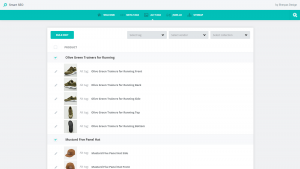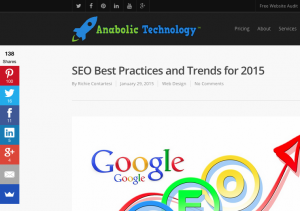Online sales accounted for more than half of total retail sales growth in 2015, according to the U.S. Commerce Department. Ecommerce sales remained strong in 2015 and online sales totaled $ 341.7 billion for the year. For online retailers, accomplishing this kind of success is no easy feat.
A well designed ecommerce website will provide an exceptional customer experience, but managing an ecommerce  website can be challenging and time consuming. Operating an ecommerce business requires business owners pay close attention to tons of details – everything from inventory control to pricing to team collaboration.
website can be challenging and time consuming. Operating an ecommerce business requires business owners pay close attention to tons of details – everything from inventory control to pricing to team collaboration.
The success of any ecommerce business depends on many moving parts. Hundreds of online tools are available to help businesses manage day-to-day tasks. Here’s a list of 17 tools to get you started.
Analytics
It’s crucial for ecommerce businesses to understand the marketing data collected using various analytics tools. Knowing what the data means can help businesses make informed and strategic decisions related to marketing, sales and other areas of the business.
#1. Clicky is a web analytics tool that allows users to access system information in real time. Cicky has a unique feature that a lot of other analytics tools don’t have: it can track Ajax and Flash events. This analytics tool is best for small to medium size ecommerce businesses.
#2. GoSquared provides real time revenue metrics and sales figures. GoSquared allows users to quickly and easily compare revenue and sales data to previous weeks or months. This tool also provides revenue and conversion predictions.
#3. Metrilo is a tracking tool that allows users to track product performance and conversions across all devices. Metrilo also creates funnel reports that provide an overview of the customer’s purchasing process.
Product Pricing
Competitive intelligence is very valuable for ecommerce businesses. Automated product pricing tools help ecommerce businesses remain competitive. The ability to make smarter sourcing and pricing decisions helps businesses drive sales and increase revenue.
#4. CamelCamelCamel tracks pricing data on Amazon products allowing users to gain a better understanding of a product’s sales performance. Users can setup history charts, price watches, and price drop alerts. Access to this type of data helps businesses make more informed decisions while product sourcing.
#5. UpstreamCommerce tracks, compares and analyzes current and historical competitor pricing data. The software helps users develop an actionable pricing strategy. UpstreamCommerce also helps users remain competitive with their pricing.
User interaction
It’s important for ecommerce businesses to monitor website visitors’ behavior. Knowing what visitors are doing – and how you can get them do more of it – can help increase conversions. User interaction tools can help ecommerce businesses determine what’s going on when visitors get to their website and how they can capitalize on that behavior.
#6. Chalmark is a user interaction tool that allows users to get feedback on designs before those designs are implemented. With Chalmark, users can perform first click testing – tests that ask people to click on what they would look at first – on screenshots and visual designs.
#7. Bounce Exchange tracks website visitors’ cursor movements in real time. When a visitor is exiting the website, Bounce Exchange serves them a call-to-action that includes a special offer. This tool helps capture visitors before they leave your website.
Content management
A dependable content management system is a necessity for any ecommerce business to function efficiently. A good content management system streamlines content publishing and almost all of an ecommerce business’s daily activities.
#8. Magneto is an ecommerce platform built on open source technology. This inventory control system is a content management tool that offers users a lot of control of their online store. Magneto allows control of the content and functionality of your online store and offers additional extensions to broaden the platform for specific functionality.
#9. PrestaShop is an open source ecommerce content management tool that comes with over 275 features. PrestaShop is designed for small and medium-size businesses. Users can track visitors, view customer profiles, track orders and sales, catalogue statistics and track affiliate Statistics.
#10. OsCommerce is an open source online store management software program. It has over 7,000 free add-ons that can be used for customization. OsCommerce can be used on any web server that has PHP and MySQL installed.
Cloud storage and back-up
Storing data in the cloud offers ecommerce businesses many advantages. Backing up data using external hard drives or backup tapes isn’t always easy, simple, secure or affordable. Cloud storage makes system backups fairly simple and affordable for most businesses. Cloud storage also makes it more affordable to perform routine backups on a more consistent basis.
#11. Carbonite provides data backup, rapid recovery and 24-hour access to your data from anywhere. Carbonite provides ongoing backups for your data and works on both the Windows and Mac operating system. Carbonite’s cloud backup and recovery plans are designed for small and midsize businesses, in addition to home offices.
#12. Mozy provides automated cloud storage for backup protection and syncing. Files are encrypted and accessible remotely, even from a smartphone. Mozy’s smart data protection knows which files to backup and when.
#13. CrashPlan creates multiple copies of your data and allows mobile file access. CrashPlan provides continuous local and offsite backup protection. There are no storage size limits, file-type restrictions or caps on bandwidth.
Team collaboration
Team collaboration can help simplify ecommerce business processes. When teams function cohesively, business operations are simplified, the company saves money and the organization runs more efficiently. Teams are more productive and efficient when they work together and collaboration tools can help make that happen.
#14. Pingboard: This Org chart software builds interactive organizational charts designed to share within the company. This software makes it easy to keep track of each team member’s skills, interests, and team information. Team members can view the org chart from anywhere, including their mobile device.
#15. Trello is designed specifically with teamwork in mind. Trello’s drag and drop design allows users to manage projects by simply dragging cards between lists to indicate a project’s progress. Trello is a visually-driven project management tool that simplifies team collaboration.
#16. Skype collaboration tools include group audio calls for up to 25 people and video conference calls for up to 10 people. Businesses can create accounts and allocate credit, subscriptions and features for teams. Skype-to-Skype communication is free and the software is accessible on desktops, smartphones, and tablets.
#17. Teamwork is a team collaboration and task management tool that combines project management with billing, reporting, time logging, real time messaging and trouble ticketing. Teamwork has a central file management system, email and Google Drive integration, and a simple price structure based on users.
Experts predict that more traditional retailers will turn to ecommerce, small businesses will find it harder to compete with online retailers, and marketing automation and integration will be the key to success.
Forrester Research predicts that ecommerce revenue will increase by 45 percent in 2016, reaching a total of $ 327 billion, and it will account for almost 9 percent of total retail sales. Online retailers have to be as efficient and profitable as possible to enjoy this kind of success.
This article first appeared on Huffington Post.
Digital & Social Articles on Business 2 Community(101)








